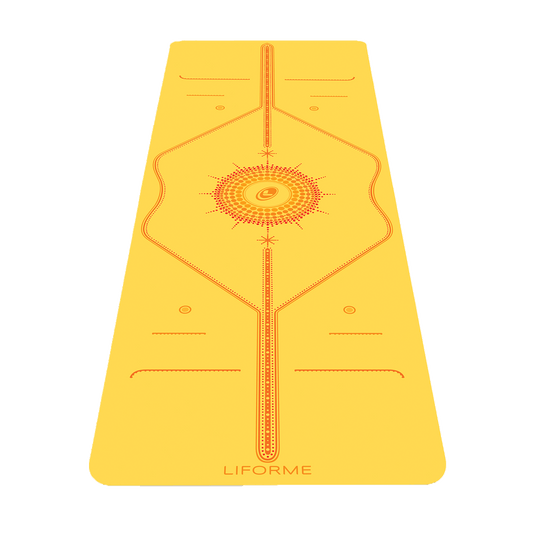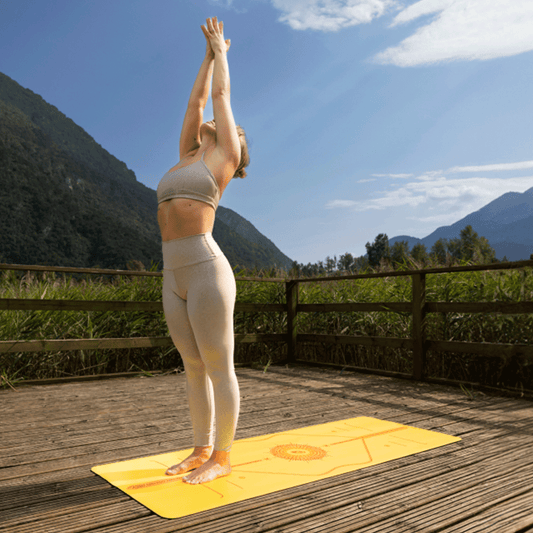Many of Plow Pose’s benefits stem from it being an unfamiliar position. It’s good for you to put your body into new shapes because it brings your attention to neglected places, giving them the opportunities to open and strengthen.
However, you must approach poses like this with some caution for the very same reasons: neglected places are often vulnerable places. For Halasana, this means going slowly, understanding the key alignment points, and using props for support.
Flowing styles of yoga may take you briefly through Plow Pose, but if you’re settling in for a longer hold, use a full complement of props for your comfort and safety.
Plow Pose Basics
Sanskrit Meaning: Hala (Plow) Asana (Pose)
Yoga Level: Intermediate
Pose Type: Inversion
Benefits: Stretches the neck and spine. Strengthens the back and core. Opens the shoulders and backs of the legs.
Precautions: Avoid this posture if you have glaucoma or a neck injury.
Props:
- Two or three blankets, folded in fourths so they are around the same width as your yoga mat.
- A wall or a chair for your feet if they don’t easily reach the floor when taken overhead.

Key Alignment Cues to Keep in Mind
- The blankets’ purpose is to lift your shoulders so that the curve of your cervical spine (the neck) isn’t flattened against the floor. When using blankets, set them up at the very end of your mat. When you come into the pose, place your shoulders on the blankets and the back of your head on the bare floor. This also allows your head to move freely so the neck isn’t crunched.
- Stack your hips over your shoulders. This can be hard to feel, so ask a teacher or friend to give you some feedback.
- Keep your gaze upwards. Don’t turn your head to the side while there is pressure on your neck.
- Halasana is based on having your feet rest on something. If your feet don’t come to the floor, use a wall or a chair as a prop. Leaving the feet dangling in the air is not the posture.
Step by Step Instructions
- Come to lie on your back with your arms by your sides, legs bent, and knees pointing toward the ceiling. If you are using blankets for support, set them up at the end of your mat as described above.
- Lift your feet off the floor and straighten your legs so they are perpendicular to the floor.
- Use your abs to take your legs over your head.
- Flex your feet so that your toes are curled under as they make contact with the floor behind your head.
- Bend your elbows and bring your hands to your back.
- Walk your feet away from your head until your hips are stacked over your shoulders.
- Release your arms to the floor. You can clasp them behind your back or keep them on either side of your body.
- Hold for around five breaths, then release the hands if they are joined and roll down one vertebra at a time until your back is flat on your mat.
Tips for Beginners
- You can bend your knees slightly if necessary.
- If your feet are not close to the floor, you’re going to want to use a wall or a chair to support them. You really want the feet to have something under them. The tricky part about using a prop for your feet is figuring out how far away from it you need to set up your pose. This is a trial-and-error situation, so take a few attempts to figure it out.
- If you use a wall, over time you may be able to walk your feet down the wall toward the floor.
Variation
Side Plow (Parsva Halasana)
While in full Halasana, walk your feet to the right and then the left side. Keep your upper body stationary, just moving the lower body.
Related Postures
A more restorative inversion that stretches the backs of the legs.
Shoulderstand (Salamba Sarvangasana)
Shoulderstand can follow from Plow or vice versa. Many of the alignment points carry through both poses, particularly hips over shoulders. If you use blankets as props for Plow, you can use them for Shoulderstand too.

Ear Pressure Pose (Karnapidasana)
From Plow, bend your knees until your shins come to the mat.
Hug your knees in toward your head, putting slight pressure on your ears.
Over the Top
If you’ve tried Plow and thought, this is not for me, using props may be the answer. Using a wall or a chair behind your head has the effect of raising the floor to your feet, which immediately makes the pose more accessible.
Lifting your shoulders with a few folded blankets can make your neck much more comfortable as well. Using props is not cheating, it’s a way to ensure that you can sustain your practice over a long period of time, which is the key to experiencing all yoga’s benefits.






































